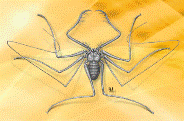Papers in the Biological Sciences

Eileen Hebets Publications
Document Type
Article
Date of this Version
2021
Citation
COREY ET AL.: Spider Prey of Mud-Dauber Wasps in Nebraska. J. Entomol. Sci. 56(2): 123–140 (April 2021)
Abstract
Predator diets represent a potential interaction between local prey availability, prey antipredator defenses, and predator foraging behavior. Female spider-specialist muddauber wasps (Hymenoptera: Sphecidae) collect spiders and provision them intact, but paralyzed, to their developing larvae, providing a unique means of quantifying the diversity and abundance of prey that they capture. Mud-dauber wasps are hypothesized to be a major source of selection on antipredator defenses in web-building spiders, and the spiny and thickened abdomens of female spiny orb-weaving spiders (Araneae: Araneidae) are hypothesized to function as antiwasp defenses. We inventoried spider prey from nests of the mud-dauber wasps Sceliphron caementarium (Drury) and Chalybion californicum (Saussure), and surveyed for spider fauna in areas surrounding nest collection sites, to specifically investigate if the spiny orb-weaver Micrathena gracilis (Walckenaer) was collected as prey by these wasps. We collected nests from six sites in southeastern Nebraska from two regions that we classify based on habitat—a forest corridor and agricultural land. We collected 761 intact spider prey from 87 nests and identified them to the family level. None of these spiders were M. gracilis. Micrathena gracilis were rare in faunal surveys on agricultural land and, surprisingly, absent in forest corridor surveys. Mud-dauber wasps were more common; we collected more spiders on agricultural land than in the forest corridor. We propose that in agricultural landscapes, the lack of certain spiders in mud-dauber wasp nests is driven by habitat use differences between predators and prey rather than physical antipredator defenses.
Included in
Animal Sciences Commons, Behavior and Ethology Commons, Biology Commons, Entomology Commons, Genetics and Genomics Commons


Comments
Copyright © 2021 Tyler B. Corey, Earl Agpawa, and Eileen A. Hebets.